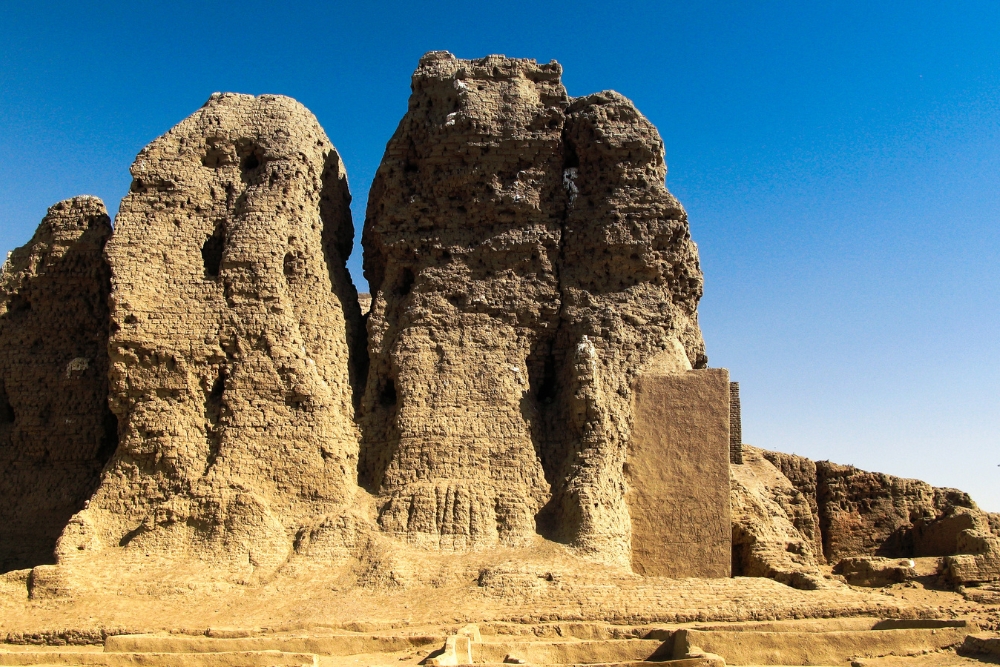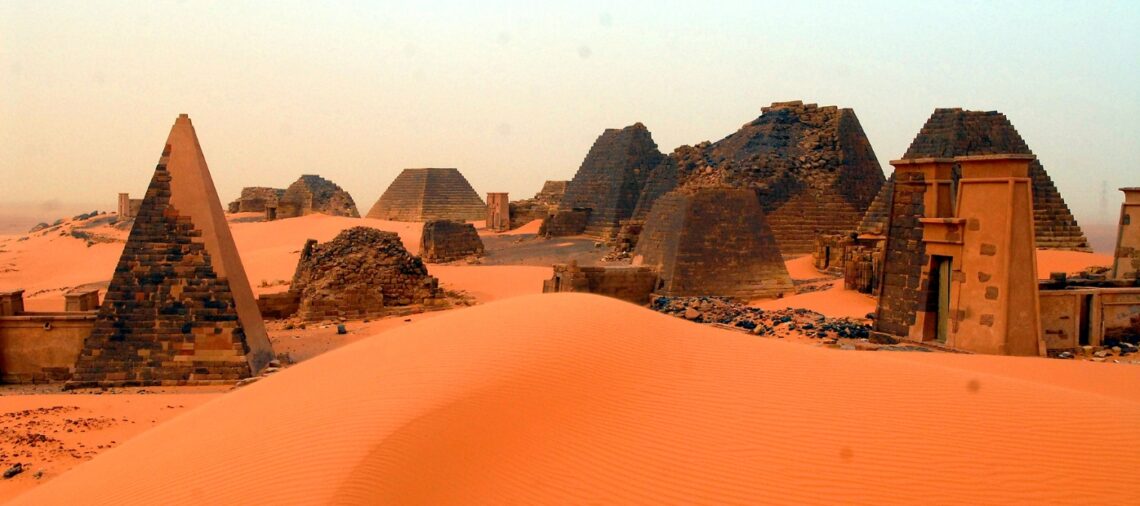Step into a time machine, where the ancient world unfolds before your eyes like a vivid painting. Sudan, a treasure trove of history and mystery, invites you to embark on a captivating journey through its ancient archaeological sites and ruins. From the majestic Pyramids of Meroe, rising from the sandy landscape like ancient sentinels, to the enigmatic Temples of Jebel Barkal, perched atop a sacred mountain, Sudan’s rich history is waiting to be discovered.
But that’s not all; the Royal City of Napata, the Naga Archaeological Site, Musawwarat Es-Sufra, the Ancient City of Kerma, and the Gebel Barkal Archaeological Site are also poised to transport you back in time. Each site holds its own secrets, whispers of a past civilization that thrived in these very lands. Are you ready to unlock the mysteries of ancient sites in Sudan?
Pyramids of Meroe

Step back in time and explore the majestic Pyramids of Meroe, an ancient wonder that will transport you to the heart of Sudan’s rich and fascinating history. The Meroe pyramids, located near the Nile River, stand as a testament to the once-powerful Kingdom of Kush, which flourished from around 800 BC to 350 AD.
These pyramids, numbering over 200, were built as burial sites for the rulers and elite members of the kingdom. Rising proudly against the desert landscape, their distinctive shape and intricate design showcase the architectural brilliance of the ancient Nubians. Each pyramid is constructed using thousands of sun-baked bricks, meticulously stacked to create the steep steps leading to the summit.
The historical significance of the Meroe pyramids cannot be overstated. They provide a glimpse into the advanced civilization that thrived in this region, with its own unique culture and traditions. The pyramids serve as a reminder of the once-mighty Kingdom of Kush, which boasted a powerful military, a flourishing economy, and a rich artistic and intellectual heritage.
Temples of Jebel Barkal

Nestled amidst the rugged beauty of Jebel Barkal, the Temples of Jebel Barkal beckon you to uncover the secrets of an ancient civilization. These magnificent structures stand as a testament to the historical significance of Jebel Barkal and its rich cultural heritage. As you explore the temples, you will be transported back in time, witnessing the grandeur and splendor of the ancient kingdom that once thrived here.
The Temples of Jebel Barkal were built by the ancient Egyptians and later expanded upon by the Nubians. They served as important religious and political centers, dedicated to the worship of the gods and the pharaohs. The most prominent temple is the Great Temple of Amun, which dominates the site with its towering columns and intricate carvings. It is believed to have been the center of religious ceremonies and royal rituals.
Despite the passage of time and the ravages of nature, the Temples of Jebel Barkal have managed to retain their allure and beauty. However, their preservation is not without challenges. Conservation efforts for Jebel Barkal are ongoing, with initiatives focused on protecting the structures from further deterioration and ensuring their cultural significance is not lost to future generations.
Royal City of Napata

As you continue your journey through the ancient archaeological sites of Sudan, the next destination that awaits you is the Royal City of Napata, a captivating testament to the grandeur and power of a once-thriving civilization. Stepping into this ancient city, you’ll be transported back in time to the height of the Napatan civilization, where kings reigned and monumental structures adorned the landscape.
The Royal City of Napata was the political and religious center of the Kingdom of Kush, which flourished from the 8th century BCE to the 4th century BCE. This remarkable site showcases the remarkable exploration techniques employed by the ancient Napatans, who built their city on the eastern bank of the Nile River.
One of the most striking features of the Royal City of Napata is its impressive Napatan architecture. The city is adorned with magnificent temples, grand palaces, and royal tombs, all constructed with precision and grandeur. The temples, in particular, stand as a testament to the religious devotion of the Napatans, with their towering columns, intricate carvings, and intricate hieroglyphics.
Exploring the Royal City of Napata, you’ll be awestruck by the sheer scale and beauty of the ancient ruins. From the remnants of the Great Temple of Amun to the royal burial sites at El-Kurru and Nuri, each step you take unveils the rich history and cultural legacy of the Kingdom of Kush.
Naga Archaeological Site

Located amidst the vast desert landscape of Sudan, the Naga Archaeological Site stands as a mesmerizing testament to the ancient civilizations that once thrived in this remote corner of the world. Stepping onto this sacred ground, you can’t help but feel the weight of history that surrounds you. With its rich cultural significance, the Naga Archaeological Site offers a glimpse into the past, showcasing the ingenuity and creativity of the people who once called this place home.
The Naga Archaeological Site is renowned for its well-preserved temples and pyramids, which date back to the ancient Kingdom of Kush. As you explore the ruins, you’ll be awestruck by the intricate carvings and detailed hieroglyphs that adorn the walls, telling stories of gods, pharaohs, and daily life in this vibrant civilization.
Preservation efforts have been instrumental in safeguarding the Naga Archaeological Site, ensuring that future generations can continue to marvel at its splendor. Archaeologists and historians have worked tirelessly to restore and protect the structures, allowing visitors to experience the site in all its glory.
Musawwarat Es-Sufra

Step into the ancient world of Sudan and discover the captivating wonders of Musawwarat Es-Sufra. This archaeological site, located in the heart of the country, will transport you back in time to a bygone era of grandeur and splendor. Musawwarat Es-Sufra is renowned for its remarkable architectural features and its historical significance.
As you explore the site, you will be greeted by the imposing Great Enclosure, a massive structure that once served as a religious and administrative center. Its walls, adorned with intricate carvings and reliefs, tell tales of ancient rituals and ceremonies. The unique layout of the enclosure, with its labyrinthine corridors and hidden chambers, adds an air of mystery to the site.
One of the most striking features of Musawwarat Es-Sufra is the Lion Temple, a sanctuary dedicated to the lion-headed deity Apedemak. The temple is adorned with magnificent lion statues, symbolizing strength and power. It is believed that the temple was a place of worship and pilgrimage, drawing people from far and wide.
Beyond its architectural beauty, Musawwarat Es-Sufra holds great historical significance. It was a major center of the Kushite civilization, playing a crucial role in the trade routes that connected ancient Africa with the Mediterranean world. The site’s strategic location made it a hub of cultural exchange and economic activity.
Ancient City of Kerma

Take a journey through time and uncover the mysteries of the Ancient City of Kerma, a captivating archaeological site in Sudan. As you step into this historical wonder, you’ll be transported back to a time when the city thrived as the capital of the Kingdom of Kerma, one of Africa’s earliest civilizations.
Kerma’s cultural significance is immense. It was a bustling metropolis, a center of trade, and a hub of political power. The city flourished between 2500 and 1500 BC, leaving behind a rich legacy that offers a glimpse into the lives of the ancient Nubian people.
The architectural features of Kerma are truly awe-inspiring. The city was divided into two main areas: the southern part, known as the Western Deffufa, and the northern part, known as the Eastern Deffufa. These massive structures, made of mud bricks and rising over thirty feet high, served as religious and ceremonial centers. They are a testament to the advanced engineering skills and artistic abilities of the Kermans.
As you explore the ruins of Kerma, you’ll witness the remnants of grand palaces, temples, and tombs. The intricate carvings and decorations on the walls speak volumes about the city’s cultural and artistic achievements. The city’s layout, with its streets, houses, and public buildings, offers a glimpse into the daily lives of its inhabitants.
Final Thoughts About Ancient Sites in Sudan
Discover Sudan’s sensational ancient sites and satisfy your curiosity for history. From the majestic Pyramids of Meroe to the mystical Temples of Jebel Barkal, immerse yourself in a world of wonder. Uncover the secrets of the Royal City of Napata and the Naga Archaeological Site. Marvel at the intricate beauty of Musawwarat Es-Sufra and the Ancient City of Kerma. Unearth Sudan’s hidden treasures and let the echoes of its past enchant your soul.



